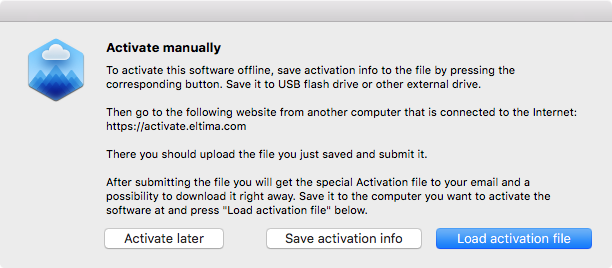

- #Eltima cloudmounter pdf#
- #Eltima cloudmounter full#
- #Eltima cloudmounter password#
- #Eltima cloudmounter download#
- #Eltima cloudmounter free#
Import new Azure Users from CSV with the ability to include most common attributes with specific rules to define password complexity requirements. Multi-Tenant Reporting and Management in single pane of glass! Single view vs multiple portal windows.Single view vs multiple portal windows.Īzure Account Provisioning and Deprovisioning - Easily create and delete users with time saving options. Azure Active Directory, SharePoint Online and Exchange Online.

Reporting and Management for Microsoft 365.
#Eltima cloudmounter free#
TruGrid includes free setup and can be implemented company-wide in less than 1 hour Supports Windows, Mac, iOS, Android, and Chrome endpoints Ĝomplement or eliminate the complexity of Microsoft Remote Desktop Services (RDS) Ĝonnect to multiple cloud desktops, including Azure, AWS, or any datacenter Meet PCI / HIPAA compliance for exposed RDP Ports Implement a Remote Access solution with Zero Trust
#Eltima cloudmounter full#
Ĝonnect to full desktops or individual apps Stop cost & pain of multiple add-ons (VPN+MFA+RDP) with one solution Ğliminate threat of spreading ransomware via VPN connections to Office Help IT Admins quickly secure RDP and VDI without exposing firewalls Implement the safest and fastest "Work from Home" solution Securely connect employees to their Office PCs, Virtual Desktops, or RemoteApp anywhere Quitting CloudMounter and reopening it yielded a successful decryption, but for a moment there, I had to wonder whether I'd lost that file forever.TruGrid SecureRDP is the preferred Remote Desktop & RemoteApp solution for Service Providers, Windows Hosting companies, ERP Vendors, and Business IT. The third, for unknown reasons, remained encrypted, no matter how many times I tried to decrypt it. I scrambled a Google Drive directory containing three PowerPoint files, then tried to unscramble it. More concerningly, my tests showed that decryption did not always, you know, decrypt. I confirmed that a batch of non-Google Docs files encrypted on my Google Drive were showing up as indecipherable gibberish, even when I checked them via the Web. I'm honestly not sure why you'd need to, though. Once a drive or directory is encrypted, you can further lock or unlock it with the same password you used to encrypt it, preventing any additional alterations. If you forget one, you'll have to manually look it up in the Keychain Access app, where it'll be stored not under "CloudMounter," but under the name of the particular drive or directory you've encrypted. You also can't use the Keychain to retrieve passwords from within CloudMounter.

You have to enter it twice to find out whether you've accidentally incorporated any typos. There's also no way to see the password you're typing. (A handful of files took two to three minutes if you're encrypting or decrypting big chunks of data, expect a long wait.)ĬloudMounter doesn't make it easy to create passwords though you can add passwords to the Keychain, you can't use its ability to suggest new passwords the way you can in web forms. Right-click any folder on your CloudMounter drives, select Encrypt from the pop-up menu, choose a password, and wait a few minutes while CloudMounter chugs through its 256-bit encryption scheme. This great idea, in theory, might need a little more polish in practice.Įncrypting and decrypting whole drives or directories - you can't encrypt individual files – works simply enough. It can scramble any non-Google files on your remote storage so that anyone not using your particular copy of CloudMounter sees only gibberish files - even when logging in via a web interface. Tales From the EncryptedĬloudMounter prominently boasts of its encryption abilities.
#Eltima cloudmounter download#
I downloaded it using Google's web interface, where it remained perfectly intact, deleted it from the cloud, re-uploaded it, and a second download worked fine.
#Eltima cloudmounter pdf#
One PDF file I downloaded from my Google Drive just wouldn't open, citing file errors. Google Docs files are their own proprietary format, so you won't get much out of copying them to your desktop. I only experienced a few bumps when moving files back and forth. You can see all your drives, and mount, unmount, or encrypt them, or display them in the Finder, via the discreet CloudMounter icon up on the right side of the menubar. Nifty little icons next to their file names in the Finder show you whether they're uploading, downloading, etc. Dragging files to and from them felt seamless, and uploads took no longer than they do for iCloud – and often felt much shorter. Once setup and mounted, those drives worked like any other on my Mac. CloudMounter works with a whole buffet of services and technologies, including Dropbox, Google Drive, OneDrive, Box and more.


 0 kommentar(er)
0 kommentar(er)
